|
AD 284-305: Diocletian and the
Tetrarchy
AD 284: Diocletian became Roman Emperor. He split
up the empire through power-sharing, and had some military successes. He
also failed to control inflation through coinage reform, and persecuted
Christians to discourage the spread of their doctrine.
286: Diocletian promoted Maximian (Caesar of the Western
Empire) as co-emperor.
293: Diocletian begins the Tetrarchy or Rule of Four (fig.1),
splitting the empire into four parts. Keeping the East for himself, Diocletian
along with Maximian appointed Galerius and Constantius Chlorus as Caesars.
297: Galerius wins victory over Persians; within a
year, all four emperors stage successful military campaigns, focusing on
spe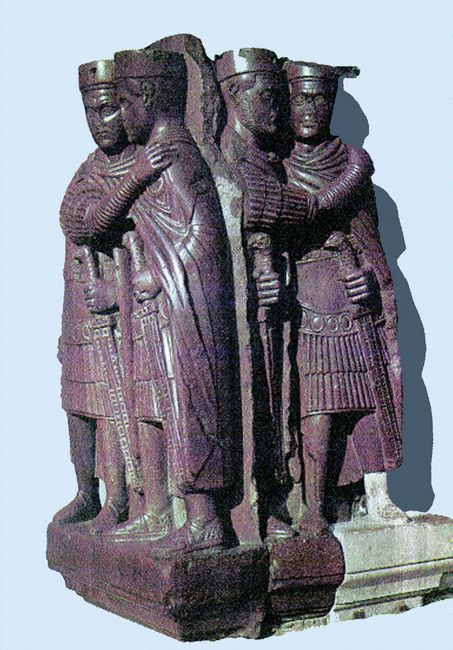 cific regions. cific regions.
303: “The Great Persecution” of Diocletian
begins on Oct. 3 ordering Christian churches to close and give up scriptures,
with the clergy required to perform pagan sacrifices.
305: Diocletian voluntarily abdicates, forcing Maximian
to do so as well. Galerius and Constantius Chlorus (father of Constantine
the Great) become the new Augusti, but the new Caesars are disputed. Constantine
flees Galerius’ court and joins his father in Britain. Maximinus Daia
and Severus are appointed Caesars. Fig.1: Statue of the four rulers of the Tetrarchy, in St. Mark's Basilica in Venice (photo:
Athena Review). .
AD 306-312: Constantine I
306 (25 July): Constantius Chlorus dies at York. The
army declares his son Constantine as emperor, but Galerius only accepts him
as a Caesar. Constantine then rules
in Gaul and Britain for the next six years.
307: Constantine marries Fausta, daughter of former
Emperor Maximian, who had taken over Italy with his son Maxentius.
310: Suicide of Maximian after he had opposed Constantine.
311: Emperor Galerius restores freedom of religion
before dying at Sirmium. Constantine and Licinius take over Italy.
312 (27-28 October): Constantine confronts Maxentius
and his army at Saxa Rubra, 8 miles northeast of Rome. The night before the battle,
Constantine dreams about the Christian Chi-Rho sign (fig.2), which he is told to
paint on his arms or shields. On the next day, he has a vision of a cross
over the sun and the words 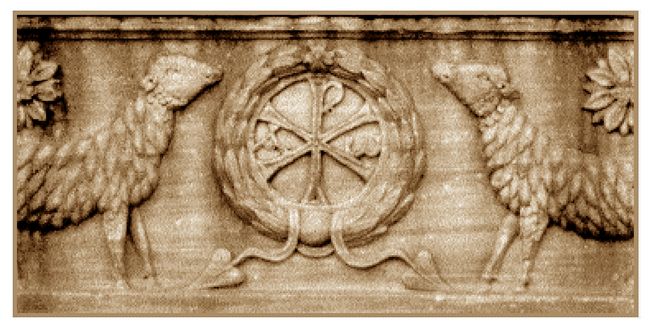 “conquer with this,” and dreams of meeting
with Christ. Winning a decisive battle over Maxentius at Milvian Bridge,
Constantine now becomes ruler of the entire Western Empire. “conquer with this,” and dreams of meeting
with Christ. Winning a decisive battle over Maxentius at Milvian Bridge,
Constantine now becomes ruler of the entire Western Empire.
Fig.2: Christian chi-rho sign on coffin with two lambs (photo: Athena Review).
AD 313: The Edict of Milan, declaring freedom of worship,
returns all previously confiscated property to the Church. Official conversion
of the Roman Empire begins. By the same agreement, Licinius allows Constantine
to keep territories he had conquered, and marries his sister, Constantia.
323: Constantine (fig.3) defeats Licinius in Adrianople, Thrace,
to become sole emperor.
326-330: Constantine visits Rome where his refusal
to attend a pagan sacrifice on the capitol offends local populace. Accordingly,
Constantine begins to promote Constantinople (on the site of ancient
Byzantium,Turkey) as the “New Rome.” On 11 May, 330 Constantine
attends High Mass in Constantinople, dedicating the city. This marks the
official start of the Byzantine Empire.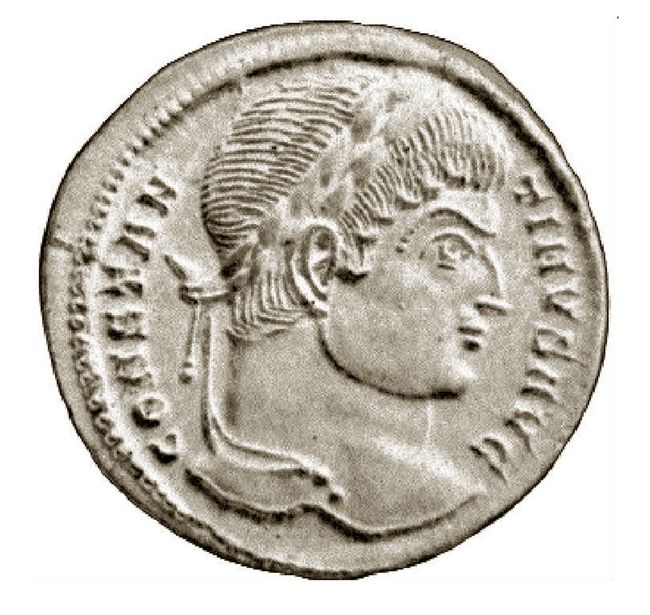 331-334: Constantine closes down all pagan temples
in the empire.
337 (22 May): Constantine, on his deathbed, is finally
baptized and appoints his three sons (Constantine II, Constantius, and Constans)
as Caesars. They divide up the empire, giving the largest part, including
Constantinople, to 15 year-old Constans.
Fig.3: Bronze coin of Constantine I, "the Great" (photo: CNG).
339: Constans exchanges Constantinople to Constantius
for his support against Constantine II.
340: Constantine II invades Italy, then Gaul, but
is ambushed and killed by Constans outside Aquiliea.
340-350: Constans maintains power but in 10 years
has become unpopular, threatened with an army revolt. In 350 Magnentius,
a pagan officer, declares himself emperor. Constans flees, is captured, and
killed.
351: Constantius defeats Magnentius at Mursa, and
became sole ruler of the empire. .
AD 355-363: Julian the Apostate
355: Constantius, faced with Germanic hostility,
conspiracies in his own army, and the need for a separate emperor in the
west, appoints as Caesar his closest remaining relative, Flavius Claudius
Julianus (fig.4). Julian (later “the Apostate”), a student of Greek
philosophy, attempted an ambitious revival of pagan practices,
which compounded 4th century religious struggles.
357: Julian wins a major victory over the Franks.
In the east, Constantius repels a major invasion in Mesopotamia.
359: 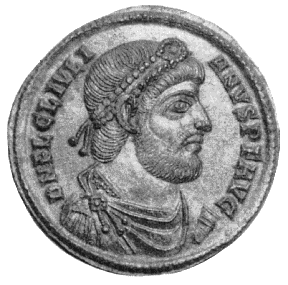 King Shapur of Persia captures the fortress at
Amida. King Shapur of Persia captures the fortress at
Amida.
360: Julian restores imperial rule along the entire
Western frontier, but refuses Constantius’ demands for reinforcements
against the Persians. 361 (30 Nov.): Civil war is averted when Constantius
gets malaria and dies. Julian, as sole emperor, attempts to restore worship
of the ancient gods.
363 (5 March): Julian departs for the East with 90,000
men to fight the Persians, and dies a few months later from a spear wound
in battle.
Fig.4: Gold coin (solidus) of Julian II , "the Apostate” ( photo: CNG 1997). .
AD 376-476: The Huns, Goths, Vandals, Theodosius,
and Stilicho
376: Westward expansion of Huns forced Ostrogoths
across the Danube; Emperor Valens allows them to settle in Thrace, ordering
local officials to give them food and shelter. Lupicinius, Count of Thrace,
steals from them instead, leading to attack on the Romans by Ostrogoths,
Visigoths, and Huns.
378:
Valens dies in battle in the Balkans. Gratian, the next emperor, seeks help
from Theodosius, a skillful military leader and general’s son who is
raised to co-Augustus. In 380, Theodosius (“The Great”) makes peace
with the Goths and creates order in Thrace.
383: The usurper Magnus Clemens Maximus, a general
in Britain, is acclaimed Augustus by his men. Gratian murdered, due to his
sympathies for Germanic barbarians.
388: Massacre at Thessalonica: soldiers of Theodosius
kill 7,000 townspeople in Hippodrome.
395 (17 Jan.): Death of Theodosius the Great, last
emperor of a united Roman Empire. His two sons, Arcadius and Honorius, rule
East and West. Stilicho (fig.5), a Vandal and second in command of Goths
in the Army, is made responsible for Honorius.
400: The Goths revolt under Alaric, first in command
of the Goths in the Imperial Army.
401: Alaric invades Italy, demanding a home for his
people in the empire; but is refused by both the Senate and emperor.
402 (April): Indecisive battle near Milan between
Go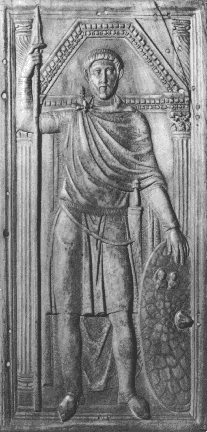 ths and Romans (Alaric vs. Stilicho). Alaric loses a subsequent battle
at Verona, but Stilicho (suspiciously) lets him escape for a second time. ths and Romans (Alaric vs. Stilicho). Alaric loses a subsequent battle
at Verona, but Stilicho (suspiciously) lets him escape for a second time.
407: Stilicho, with Alaric as an ally, effectively
declares war on the East. Meanwhile, the governor of Britain, another
Constantius, tries to usurp in Gaul.
408 (May): Arcadius dies in Constantinople and is
succeeded by his seven year old son Theodosius II.
408 (Aug.): Stilicho executed for plotting against
Honorius. Roman legionaries attack auxiliary units of Goths, Huns, and Vandals,
who seek aid from Alaric.
408 (Sept.): Alaric and Goth and Vandal armies attack
Rome. Without Stilicho, the Roman army has no effective leader, and pays
ransom to save the town. .Fig.5: Relief of Stilicho, General of the Roman Army under Honorius,
on an ivory diptich in Monza, Italy. .
AD 408-455: Honorius, Galla Placidia, and the Collapse
of the Western Empire
408 (Dec.): Honorius refuses to give Alaric territory
for loyalty and flees Rome. Seeking sanctuary in the coastal town of Ravenna,
he receives six legions from Theodosius II and more troops from Heraclian,
governor of Africa, who cuts off the barbarian’s grain supply in Italy.
409: Vandals, driven west by Huns, go to Spain.
410:
Alaric returns to Rome for another siege. Takes city in two months, and allows
three days of pillaging, with orders not to touch churches. A few days later,
Alaric dies of a fever.
414: Theodosian walls built in Constantinople, while
Theodosius’ nun-like sister Pulcheria (age 15) is proclaimed Augusta.
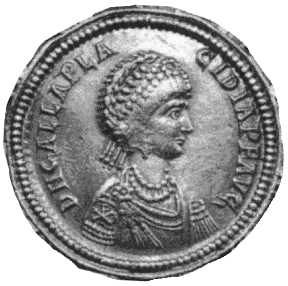 421: Theodosius marries Athenais, a Greek pagan who
converts to Christianity (renamed as Eudocia). In 422 they have a daughter,
Eudoxia.
421: Theodosius marries Athenais, a Greek pagan who
converts to Christianity (renamed as Eudocia). In 422 they have a daughter,
Eudoxia.
423: Honorius dies on 26 Aug. The empty throne is
seized by Johannes, Chief of Notaries. Theodosius confirms Galla Placidia
(fig.6) as Augusta and makes her son, Valentinian III a Caesar.
425: Byzantine armies take Ravenna, and Johannes is
executed.
.Fig.6: Galla Placidia, shown on a silver coin (photo: CNG).
428: Gaiseric, king of the Vandals, leads all 160,000
of his people to settle in North Africa.
438 (15 Feb.): The Theodosian Codex, meant to emphasize
unity of the empire, is promulgated by the rulers of East and West.
439: Gaiseric the Vandal establishes an independent
autocracy in Carthage; conquers Sicily.
447: Attila and the Huns move southeast to Constantinople.
Stopped by the Theodosian Walls, they engage the Byzantine army at Gallipoli
until Theodosius agrees to triple the tribute.
450: Galla Placidia dies after ruling in Valentinian
III’s name. On 25 July Theodosius II dies from a fall. Pulcheria marries
Marcian, a Thracian senator who refuses to pay protection money to Attila.
Huns march into Italy and Gaul.
451: Huns reach the walls of Orléans. The next
year (452) Attila enters Italy but leaves without invading Rome. He soon
dies on his wedding night.
455: Valentinian is killed, leaving no heirs. Soon
afterwards, Gaiseric’s Vandal army attacks Rome. Vandals accept appeal
by the Pope Leo (the Great) to spare city, and take everything of value (plus
Eudoxia and her daughters) back to Carthage. .
AD 457- 493: Reigns of Leo I & Zeno
457: The Eastern Emperor Marcian dies, ending the
Theodosian dynasty. Army general Aspar, a barbarian and Arian leading a powerful
Germanic element, backs Leo (crowned 4 Feb 457 in Hagia Sophia) and remains
a power behind the throne. Leo undermines Aspar by putting the Isaurians
(a barbarian group under the imperial command) in the army and in positions
of power, with the Isaurian chieftain Zeno marrying Leo’s daughter Ariadne.
468: Leo launches a campaign against Gaiseric the
Vandal, led by Basiliscus, who invades Carthage with 1000 ships and 100,000
men, but lacks leadership and strategy skills. Gaiseric’s emissaries
met Basiliscus asking five days truce, after which Gaiseric was to surrender.
The Vandals used the time to prepare for war, and set fire to the entire
Byzantine fleet in the harbor.
471: Theodoric becomes leader of the Ostrogoths. Ten
years as a child hostage in Constantinople had provided him with valuable
knowledge of Byzantine affairs and methods.
474: Leo dies, and nine months later Zeno, now emperor,
signs a peace accord with the Vandals.
476: Western Empire collapses as the young Emperor
Romulus Augustus abdicates to barbarian general Odoacer. Eliminating the
Roman Imperial office altogether, Odoacer hands over to Constantinople the
insignia of the West and takes title of Patrician to rule Italy. Lacking
either imperial authority, or control of the water supply, the Bishop of
Rome is compensated with some extra secular authority, beginning the age
of the medieval Papacy.
484: Leontius sets up rival court at Antioch.
488: Illus and Leontius surrender in Isauria to Zeno
and his ally Theodoric, Prince of the Ostrogoths. On Zeno’s suggestion,
Theodoric leads the Ostrogoths to Italy to overthrow Odoacer and establish
a kingdom under imperial sovereignty.
491 (9 April): Zeno dies in Constantinople. Flavius
Anastasius ascends the throne, marries Ariadne, and cuts public expenditures.
492: Zeno’s brother Longinus, seeking the throne,
accuses Anastasius of hypocrisy for signing a declaration of orthodoxy upon
taking office. Longinus is exiled after starting a civil war. Anastasius
bans Isaurians from Constantinople; fighting continues for 3 years in Anatolia.
493 (15 March): After four years of battle, Theodoric
tricks Odoacer to enter Ravenna, then kills him. Thus begins Theodoric’s
33-year reign, which leaves Romans independent from Ostrogoths. .
AD 519-537: Justinian and Theodora
519: Anastasius dies and Justin I ascends the throne.
His nephew, Justinian, is immediately promoted from an officer in the palace
regiment to Count of Domestics, and essentially rules through his uncle from
then on.
525: Justinian marries the ex-prostitute Theodora.
527 (4 April): Justinian and Theodora are crowned
co-emperor and -empress with equal power. On 1 Aug. Justin dies, leaving
them as sole rulers.
529: The 1st edition of the Codex of Justinian is
completed, with the Digest or Pandects (a collection of writings of all ancient
Roman jurists) published in 530. The Institutes, a handbook of excerpts intended
for use in law schools, is finished in 533.
530: Justinian’s general Belisarius wins a victory
over the Persians.
532: Byzantine citizens revolt over Justinian’s
corrupt ministers, especially Praetorian Prefect Eudaimon, tax collector
John of Cappadocia, and Tribonian, Quaestor (highest law officer in the
government). The insurrection is called the Nika riots, after the cry of
“Nika!” (Win! or Victory!). Rioters burn the palace of the City
Prefect, the Praetorian Prefecture, Senate House, Church of St. Eirene, Church
of St. Sophia, and many other buildings. They call for dismissal of the three
ministers, agreed to by Justinian who is persuaded to stay by Theodora.
Belisarius and Mundus lead troops to suppress the riots, killing thousands
of citizens.
532: Byzantines and Persians sign a peace treaty.
With discontent within the empire quieted, Justinian turns his attention
to reconquering the west.
533 (21 June): A military expedition under Belisarius
to the Vandal kingdom in North Africa includes Hunnish cavalry, who strike
fear in the hearts of the Vandals. Belisarius immediately defeats the Vandal
army. Vandal king Gelimer flees westward, and on 15 Sept. Belisarius enters
Carthage, now the Vandal capital.
534: After two unsuccessful battles, Gelimer finally
surrenders.
535: Justinian sends Belisarius to conquer Italy.
536: After capturing Sicily, Belisarius takes southern
Italy as far as Naples, which puts up resistance. Barbarian soldiers are
released to pillage. Local Goths blame Theodahad for the loss of Naples,
depose and execute him, and put Vitiges on the throne. On 9 Dec. Belisarius
enters Rome. The Gothic army flees, and Belisarius strengthens the city walls
and stockpiles food and water.
537: Vitiges and the Gothic army begin a year-long
siege of Rome. Romans endure famine, while the Goths endure pestilence. The
aqueducts are cut, causing malaria. Justinian makes a halfhearted attempt
to send reinforcements. .
537-565: Belisarius and the Gothic wars
537 (Nov.): Byzantine general John is sent out by
Belisarius to harass the Goths during a truce. John then sets up headquarters
at Rimini.
538 (March): Vitiges ends siege of Rome and flees
north, pursued by Belisarius. The Goths besiege Rimini, but are expelled
as more troops from Constantinople arrive under Narses, a eunuch who was
one of Justinian’s a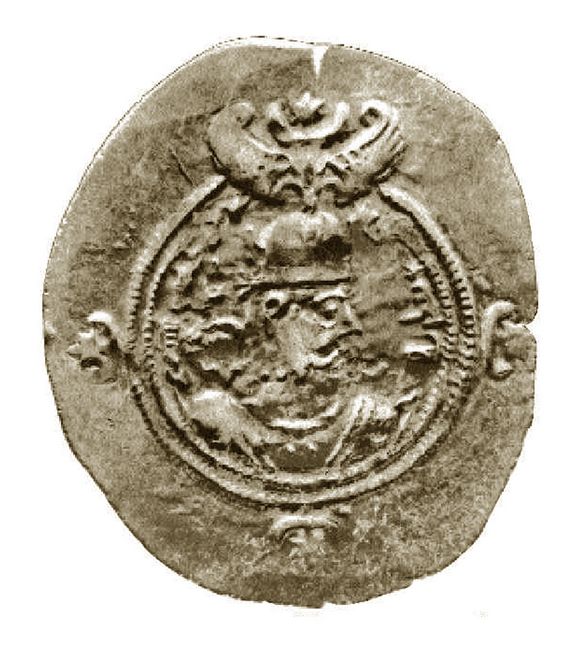 dvisors. dvisors.
539: After Belisarius’ army occupies Milan with
300 men, Vitiges lays siege and captures it. Justinian recalls Narses to
Constantinople and Belisarius regains control of the army, completing the
capture of Italy south of Ravenna. Vitiges persuades the Persian king Chosroes
I (fig.7) to attack the Byzantines and force them into war on two fronts.
540: Belisarius recalled to Constantinople. (June):
Chosroes captures Antioch; Byzantine troops sent eastward.
Fig.7: Silver coin of the Persian king Chosroes I, ca. AD 540 (photo: CNG).
542: Totila, the new Goth leader, promises lower taxes
and redistribution of rich Roman estates. Captures Naples and releases Byzantine
garrison.
543: Justinian recovers from bubonic plague and calls
Belisarius back into service. His daughter is betrothed to the empress’
grandson.
544: Totila leaves Naples for Rome. Belisarius arrives
in May with a token force which takes a few small cities. Little local support
for the Byzantines.
545-546: Belisarius asks Justinian for help and sails
up the Tiber to attack Totila from behind as he lays siege to Rome, but fails.
On 17 Dec., discontented Roman soldiers open the city gates to Totila.
548: Theodora dies.
549: Belisarius returns to Constantinople
550 (15 Jan.): Soldiers again open the gate of Rome
for the Goths, who settle in instead of raiding.
552 (June): Narses and the Byzantine army defeat and
kill Totila, then take Ravenna and Rome. In Oct. Goths agree to leave Italy.
559: Huns attack, but Belisarius stops them.
562: Belisarius, accused of plotting against the throne,
was again stripped of his title until Justinian reinstates him eight months
later.
565 (March): Death of Belisarius. On 14 Nov., Justinian
also dies. By the end of his reign, the army had shrunk, and money had dwindled
from tributes paid to various tribes for maintaining the borders. His nephew,
Justin II (now emperor) stops paying such “protection money,” thus
effectively opening up the empire to barbarian invasions.
568: The Lombards, a Germanic people, enter northern
Italy and gain ascendancy for 200 years.
This chronology appears in Vol.3, No.1 of Athena
Review.
.
|